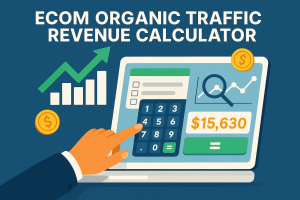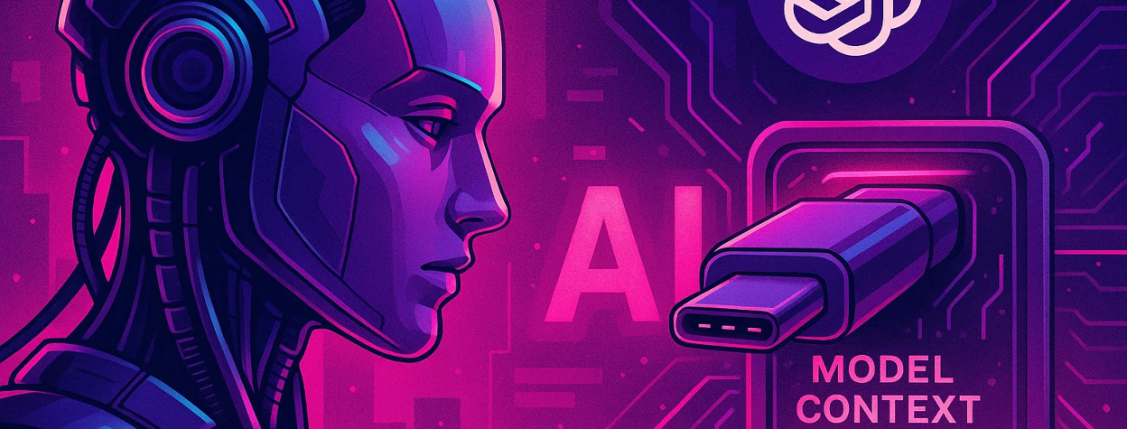Key Takeaways
- Model Context Protocol (MCP) standardizes communication between AI models and external services, eliminating the need for custom integration code.
- Just as USB-C unified device connectivity, MCP creates a universal interface for AI systems to connect with various tools and data sources.
- MCP dramatically reduces development complexity and maintenance costs by centralizing integration logic.
- Companies including Google, Microsoft, and OpenAI have already announced MCP support, signaling industry-wide adoption.
- AI development expert Dhavan Patel of CodeBasics explains how MCP works to help businesses build effective AI agent frameworks.
Integration complexity has become one of the biggest bottlenecks in artificial intelligence development – until now, that is. Because Model Context Protocol (MCP) – a standardized integration framework – is changing how AI systems connect with external services. Developed by Anthropic as an open standard, MCP functions as the universal connector for AI systems – the USB-C of artificial intelligence integrations.
Just as USB-C eliminated incompatible cables and adapters, MCP is transforming how developers build AI applications. By providing a standardized way for Large Language Models (LLMs) to communicate with external tools, APIs, and knowledge sources, MCP eliminates the need for custom integration code that has historically slowed down AI development.
What Is Model Context Protocol and Why It Matters
MCP Defined: The Universal Connector for AI Systems
MCP is a standardized framework that enables secure, two-way connections between AI models and external services. In the pre-MCP world, developers needed to write custom ‘glue code’ for each integration between an AI system and external tools or data sources. And as you can imagine, this process was time-consuming, error-prone, and created maintenance nightmares.
MCP solves this problem by establishing a common language and communication protocol. It creates a standardized interface that allows AI models to interact with various tools, knowledge bases, and APIs without requiring specialized code for each connection – which significantly reduces complexity and accelerates development.
The Evolution from Custom Code to Standardized Protocol
Before MCP, integrating AI models with external services was a complex undertaking – each integration required custom code tailored to the specific API and data format of that service. For example, connecting an LLM to a database, a search engine, and a weather API would require three separate integration efforts – each with its own maintenance burden.
And that’s why MCP is a big deal. Instead of building custom integrations for each and every service, developers can implement the standardized MCP interface once and then connect to any MCP-compatible service – just like that.
How Industry Leaders Are Adopting MCP
MCP adoption is gaining momentum across the AI ecosystem. Major companies including Google, Microsoft, OpenAI, Replit, and Zapier have all announced support for the protocol. In other words, MCP is becoming the standard for AI integrations – similar to how USB-C has become the standard for device connectivity.
How Model Context Protocol Works
The Client-Server Architecture Explained
MCP uses a client-server architecture that streamlines communication between LLMs and external services: the LLM functions as the client, while the external services operate as servers. When an LLM needs to fetch stock prices, search for locations, or retrieve document content, it sends a standardized request through the MCP framework.
This architecture creates a clean separation of concerns: the LLM focuses on understanding and generating text, while the servers provide specialized functionality.
Three Core Capabilities: Tools, Resources, and Prompts
MCP servers offer three primary capabilities that LLMs can use:
- Tools: Functional capabilities that LLMs can use to perform specific tasks, such as searching for information, calculating values, or interacting with external systems.
- Resources: Knowledge sources that LLMs can query to access information, similar to how you might look up data in a database or document repository.
- Prompts: Pre-defined templates that help LLMs generate appropriate responses for specific use cases.
Selecting the Right Tool: How MCP Makes Decisions
One of MCP’s most powerful features is its ability to help AI models choose the appropriate tools based on the parameters provided by users. When a user asks “What’s the weather in New York today?” the LLM analyzes this request, determines it needs weather data for a specific location, and then interacts with a weather service through the standardized MCP interface.
Meaning developers don’t need to hardcode decision logic into their applications. Instead, the LLM itself can determine the most appropriate services to use, making the entire system more flexible and adaptable.
The Critical Benefits MCP Delivers
1. Eliminating Integration Complexity
The most immediate benefit of MCP is the dramatic reduction in integration complexity. By providing a standardized interface, MCP eliminates the need for custom code to connect LLMs with each external service. This means that developers can integrate once and connect to many, significantly reducing development effort and time-to-market.
2. Bolstering Security and Control
MCP was designed with security as a foundational principle – with built-in features for user consent requirements, clear permission models, and granular access controls. This security-first approach enables organizations to connect AI systems to sensitive business data while maintaining appropriate security boundaries – a critical consideration for enterprise adoption.
3. Reducing Maintenance Burden
One of the biggest challenges with custom integrations is the ongoing code maintenance. When external services update their APIs, developers typically need to update their integration code accordingly. With MCP, this burden is significantly reduced. Since the integration follows a standardized protocol, changes to the underlying services are less likely to break the integration.
4. Accelerating Development Cycles
Since there is no need to write custom integration code, developers can focus on building the core functionality of their AI applications. Meaning that MCP accelerates development cycles, which can lead to faster innovation management and more rapid iteration of AI applications.
5. Future-Proofing Your AI Investments
As an open standard being adopted across the AI ecosystem, MCP helps future-proof AI investments. Applications built using MCP can easily connect to new services as they become available, without requiring major rewrites or redesigns. This way, AI applications can evolve alongside the rapidly changing AI environment.
MCP vs. Traditional API Integration
Before MCP: The Custom Code Nightmare
Traditional API integrations require developers to write custom code for each service they wish to connect with, and that leads to several challenges:
- Development Complexity: Each integration requires understanding the specific API’s documentation, authentication methods, and data formats.
- Maintenance Overhead: When APIs change, all the custom integration code must be updated accordingly.
- Scaling Limitations: As the number of integrations grows, the complexity and maintenance burden grow exponentially.
After MCP: Standardized Communication
MCP transforms this process by providing a standardized communication protocol:
- Simplified Development: Developers only need to understand and implement the MCP standard once.
- Reduced Maintenance: Changes to underlying services are less likely to break integrations due to the standardized interface.
- Improved Scalability: Adding new services becomes significantly easier, as the integration pattern is consistent.
Real-World Applications Transforming Industries
Intelligent Document Processing
In legal, financial, and administrative sectors, MCP-enabled AI systems can transform document processing. By connecting LLMs to document repositories, data extraction tools, and workflow systems through MCP, organizations can automate the extraction, analysis, and routing of information from documents – all without custom integration code for each step in the process.
Research Knowledge Synthesis
Research organizations can use MCP to build AI systems that synthesize knowledge across multiple sources. By connecting LLMs to academic databases, internal research repositories, and analysis tools through MCP, researchers can ask complex questions and receive comprehensive answers that draw on diverse sources of information.
Enterprise Data Management
Enterprise data management greatly benefits from MCP-enabled AI systems. By connecting LLMs to databases, data warehouses, and analytics tools through the standardized MCP interface, organizations can build powerful data exploration and analysis capabilities without the typical integration complexity.
Implementation Considerations for Enterprises
When implementing MCP in an enterprise context, consider the following:
- Security: Ensure that MCP implementations follow your organization’s security requirements, particularly regarding data access and authentication.
- Compatibility: Verify that the services you need to integrate with support MCP or have adapters available.
- Governance: Establish clear governance policies for how MCP-enabled AI systems can access and use organizational data.
Final Thoughts
The future of AI doesn’t depend just on building smarter models – the models also need to be able to effectively use diverse capabilities through standardized interfaces. MCP is making that future possible today, and organizations that adopt this standard will be well-positioned to build the next generation of AI applications.
Author
-
CEO and Co-Founder at AmpiFire. Book a call with the team by clicking the link below.
Related Posts

Agentic Commerce Protocol for Shopify: Setup & Guide
Learn how to prepare your Shopify store for OpenAI's Agentic Commerce Protocol (ACP). Get AI-driven sales with structured content across…

BigCommerce Payment Gateways List | Apps & Integrations For Credit Card Transactions
Check out secure payment gateways and integrations for processing credit card transactions on BigCommerce and learn how to boost BigCommerce…

Agentic Commerce Protocol Setup Guide: How to Get AI-Driven Ecom Sales in 2026
OpenAI and Stripe’s Agentic Commerce Protocol (ACP) changes how 800 million people discover and buy products. Instead of searching Google…

The Small Business Digital Marketing Business Model: Predictions For The New Normal
Ultimately crisis or no crisis I use the 7 factors of a winning industry to decide the bigger picture direction…

Selfpublishing.com: Features, Benefits & Pricing – Is it a Legit Platform for Authors?
Explore selfpublishing.com's programs, benefits, and pricing to see if it's the best platform for aspiring authors in our detailed review.

Ecommerce Organic Traffic Revenue Calulator
How to Use the E-commerce Traffic-to-Sales Calculator This calculator helps you estimate the potential increase in monthly sales revenue based…









